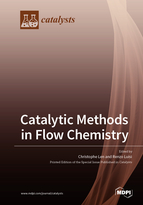Catalytic Methods in Flow Chemistry
A special issue of Catalysts (ISSN 2073-4344). This special issue belongs to the section "Environmental Catalysis".
Deadline for manuscript submissions: closed (31 January 2019) | Viewed by 52279
Special Issue Editors
2. Chimie ParisTech, CNRS, PSL University, F-75005 Paris, France
Interests: fine chemistry from natural substances: carbohydrates, cyclodextrins, nucleosides, lipids; chemistry and processes for the sustainable development; organic chemistry in green solvents; homogeneous, heterogeneous, and micellar catalysis; continuous flow applied to organic chemistry; organic chemistry under microwave activation
Special Issues, Collections and Topics in MDPI journals
Interests: organic synthesis; flow chemistry; chemistry of strained heterocycles; green chemistry; fluorine chemistry
Special Issues, Collections and Topics in MDPI journals
Special Issue Information
Dear Colleagues,
The chemical industry generates a large variety of products, including (i) basic chemicals, e.g., polymers, petrochemicals, and basic inorganics; (ii) specialty chemicals for crop protection, paints, inks, colorants, textiles, paper and engineering; and (iii) consumer chemicals, including detergents, soaps, etc. Aiming to improve the intensification of the process, chemists have recently established chemical reactions based on catalysis, as well as alternative technologies, such as continuous flow.
The aim of this Special Issue is to cover promising recent research and novel trends in the field of novel catalytic reactions (homogeneous, heterogeneous, and enzymatic, as well as their combinations) in continuous flow chemistry. Recent conversion of starting material issued from petroleum resources or biomass into high-added value chemicals will be reported.
Prof. Dr. Christophe Len
Prof. Dr. Renzo Luisi
Guest Editors
Manuscript Submission Information
Manuscripts should be submitted online at www.mdpi.com by registering and logging in to this website. Once you are registered, click here to go to the submission form. Manuscripts can be submitted until the deadline. All submissions that pass pre-check are peer-reviewed. Accepted papers will be published continuously in the journal (as soon as accepted) and will be listed together on the special issue website. Research articles, review articles as well as short communications are invited. For planned papers, a title and short abstract (about 100 words) can be sent to the Editorial Office for announcement on this website.
Submitted manuscripts should not have been published previously, nor be under consideration for publication elsewhere (except conference proceedings papers). All manuscripts are thoroughly refereed through a single-blind peer-review process. A guide for authors and other relevant information for submission of manuscripts is available on the Instructions for Authors page. Catalysts is an international peer-reviewed open access monthly journal published by MDPI.
Please visit the Instructions for Authors page before submitting a manuscript. The Article Processing Charge (APC) for publication in this open access journal is 2700 CHF (Swiss Francs). Submitted papers should be well formatted and use good English. Authors may use MDPI's English editing service prior to publication or during author revisions.
Keywords
- Catalysis
- Continuous flow reaction
- Chemical catalysis
- Enzymatic catalysis
- Chemical engineering
- Biomass valorization
- Petroleum resources
- Alternative technology
- Microwave chemistry
- Ultrasound chemistry
- Photochemistry







